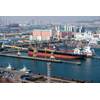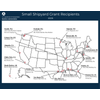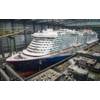LNG Lucrative for PCTC Newbuilds
A recently released study confirms that liquefied natural gas (LNG) as a marine fuel is the most financially effective for Pure Car and Truck Carriers (PCTC) on Atlantic and Pacific trade lanes.
SEA\LNG, the multi-sector industry coalition, created to accelerate the widespread adoption of liquefied natural gas (LNG) as a marine fuel, has released an independent study showing that LNG as a marine fuel delivers the best return on investment and is a competitive option for newbuild PCTC.
Peter Keller, Chairman, SEA\LNG, stated: “This is the second in a series of studies commissioned from independent simulation and analytics expert Opsiana. Similarly to the results of the liner investment case, this study shows that shipowners ordering PCTC newbuildings should take advantage of the environmental, operational and commercial benefits of LNG.”
The study considered two PCTC trading scenarios using a 6,500 Car Equivalent Unit (CEU) vessel on the Atlantic Trade and an 8,000 CEU vessel on the Pacific Trade. The study indicated that LNG as a marine fuel delivers the best return on investment on a net present value (NPV) basis over a conservative 10-year horizon, with fast payback periods ranging from one to three years on the Atlantic Trade and from less-than-one year to two years on the Pacific Trade.
These two routes were chosen based on trading scale, with approximately 3.2M vehicles shipped on the Pacific Trade and 1.7M on the Atlantic Trade every year. LNG proved to be the best investment across both trading zones. This higher investment return was achieved without including the significant additional benefits and branding value gained by choosing LNG as a more environmentally friendly marine fuel.
When corporate sustainability and environmental goals are included, including potential future charges on CO2 production, choosing LNG as a marine fuel brings additional benefits.
The study provides greater clarity for those investing in LNG and highlights six key findings: LNG has a better return on investment, the CAPEX hurdle is diminishing, it delivers competitive energy costs, has higher environmental performance, and is the most financially effective long-term method for complying with the 2020 sulfur cap. It also underlines the fact that scrubber operation is significantly more expensive than widely reported, and that the cost of LNG is stable.
The financial results are more compelling given that this higher traditional investment return was achieved by choosing LNG, the only commercially viable marine fuel alternative available at scale today which is successfully able to achieve corporate sustainability and environmental goals.
To ensure the best possible data was available to Opsiana, SEA\LNG members contributed their maritime expertise and current corporate information and data from across the LNG value chain, to guarantee a high level of creditability in the study and results. All cost data was accurate in accordance with the latest estimations from industry experts, derived from their experiences in operation.
While this study focuses specifically on the PCTC investment case for LNG within a specific trade route, the coalition continues to collaborate with third parties on further independent research which will analyse the investment case for a dry bulk vessel and a very large crude carrier (VLCC).
Keller concluded: “LNG is a safe, mature, commercially viable marine fuel offering superior local emissions performance, significant Greenhouse Gas (GHG) reduction benefits, and a potential pathway to a zero-emissions shipping industry. SEA\LNG will continue to provide factual, independently verified information that objectively supports owners and operators in decision-making for 2020 and beyond.”
Related News





